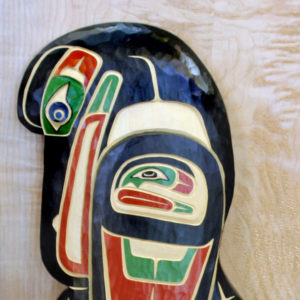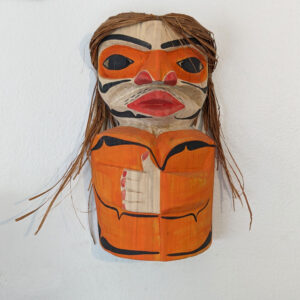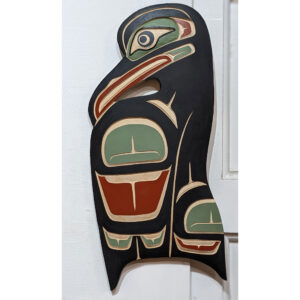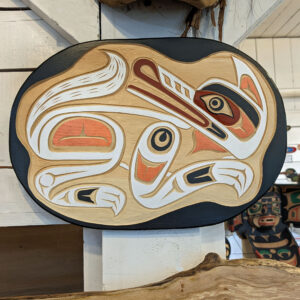First Nations Eagle and Chief Panel
$325.00
Very clean and precise carving sets this vintage Squamish Eagle and Chief wall panel apart. The yellow cedar wood has mellowed to a wonderful olive tone. Measures 14.5 x 4 x .75 inches, priced at $325.
The artist lives in North Vancouver close to family. He spends his life working as a Coast Salish (Squamish) artist. He was born in 1950.
At just 12 years old, he started carving in 1962. His great teachers were Tony Hunt, Bill Reid, and Bobby Cole. He also ventured into painting and designing totem poles. In 1972 he carved big poles that were sold to Germany. One of them was 80 feet tall. In 1980 he carved a 60-foot pole for Sea Span and another one for the Chief Joe Matthias Centre as well as the welcome figure on the West Vancouver Pier. About the same time, he started teaching and carved with children.
He was interested from a young age in the spiritual dances of the Coast Salish people and became one of the Spirit dancers. He became a teacher for these dances for many young people, who wanted to follow his footsteps. He learned to carve silver and gold jewelry and became so good at it, that he started teaching this art at the employment center.
He is now an outstanding master artist who is willing to pass on his talent to the next generation of young artists.
Sḵwx̱wú7mesh Úxwumixw (Squamish Nation) members are descendants of the Coast Salish Aboriginal people who have lived in this area since before recorded time.
A Squamish is a strong and often violent wind occurring in many of the fjords, inlets, and valleys of British Columbia. Squamish occurs in those fjords oriented in a northeast-southwest or east-west direction where cold polar air can be funneled westward, the opposite of how the wind generally flows on the Coast.
“Squamish” is a loose English adaptation/mispronunciation of Skwxwu7mesh, meaning “Mother of the Wind”, “people of the sacred water”.
Although first recorded contact with Europeans happened in 1791, disease had devastated much of the population before in the 1770s. For decades following, more diseases, including influenza, reduced the population significantly. Along with the influx of new foreigners, usurpation of their ancestral lands, and later policies of assimilation by the Canadian government, caused a significant shift in their culture, way of life, and society.





